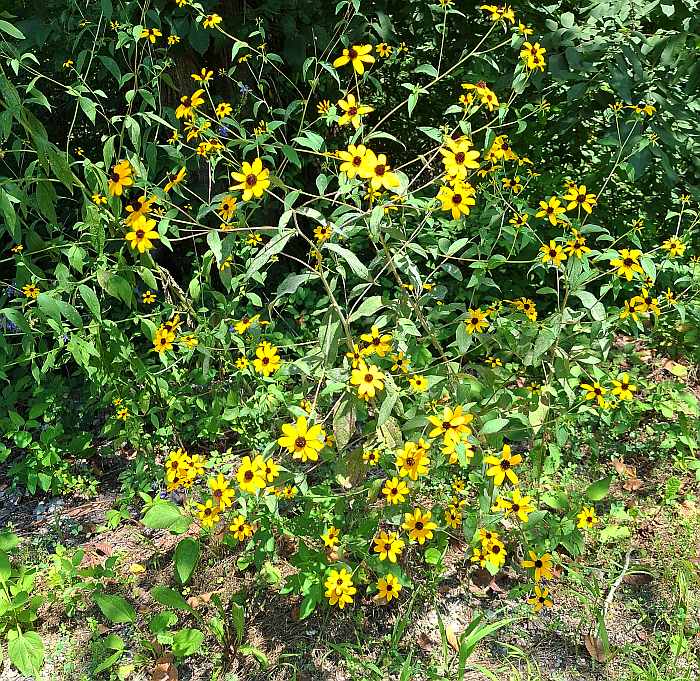Rudbeckia triloba L.
Brown-Eyed Susan

Native
CC = 3
CW = 3
MOC = 78
© SRTurner
Rudbeckia triloba L.Brown-Eyed Susan | |
 |
Native CC = 3 CW = 3 MOC = 78 |
© SRTurner |
|
Family - Asteraceae/Heliantheae Habit - Perennial forb, with fibrous roots and rhizomes. Stems - Ascending to erect, to 1.5 m, branching, sometimes extensively so, sparsely to moderately hairy with short, mostly spreading hairs, sometimes glabrous toward the base, not glaucous.
Leaves - Alternate, petiolate below, sessile above, scabrous, strigose. Basal and larger stem leaves sometimes deeply 3-lobed, tapered at the base, only slightly expanded at the base and inconspicuously wrapping around the stem, the margins entire or more commonly relatively sharply and finely to coarsely toothed, the surfaces moderately hairy with spreading, pustular-based hairs and usually also dotted with minute, sessile to impressed, yellowish glands, slightly to moderately roughened to the touch, not glaucous, green when fresh. Basal and lowermost stem leaves often wilted at flowering, with long, mostly winged petioles, the blade 10-30 cm long, 30-100 mm wide, ovate to broadly ovate in outline, the lobes (when present) elliptic, ovate, or oblong-lanceolate, angled or tapered to a sharply pointed tip. Median and upper stem leaves sessile to short-petiolate, the blade 1-12 cm long, 6-30 mm wide (to 90 mm in lobed leaves), the unlobed leaf blade or the lobes of a divided blade narrowly elliptic-lanceolate to ovate to elliptic, angled or tapered to a sharply pointed tip.
Inflorescence - Appearing as loose, open, leafy panicles of flowering heads.
Heads - Radiate. Involucral bracts 6-12, 5-15 mm long, lanceolate to linear, recurving, ciliate-margined, the outer surface moderately roughened-hairy. Receptacle 6-16 mm long, 5-15 mm in diameter, hemispherical at the start of flowering, then elongating and often becoming ovoid to conical. Chaffy bracts subtending only the disc florets, as long as or slightly longer than the disc florets (including the corolla), tapered to a slender, sharply pointed, somewhat awnlike tip, the outer surface glabrous (rarely with a few short hairs) and often somewhat shiny, the margins glabrous.
Flowers - Ray florets 10-16, sterile, the corollas 10-20 mm long, broad or slender, spreading to slightly drooping at flowering, usually yellow, the outer surface sparsely short-hairy and sometimes also minutely gland-dotted. Disc florets 50 to numerous, perfect, the corollas 3-4 mm long, yellowish green toward the base, dark purple to purplish brown toward the tip, the lobes ascending at flowering. Stigma lobes relatively short and bluntly pointed at the tip. Pappus a minute rim or crown.
Fruits - Achenes wedge-shaped, 4-angled, 2.0-3.5 mm long.
Flowering - June - November. Habitat - Woodland borders, thickets, rocky slopes, railroads, open disturbed areas. Also widely cultivated. Origin - Native to the U.S. Lookalikes - Other species of Rudbeckia; more broadly, many other yellow composites. Other info. - This showy species is common across the state and the upper U.S. Midwest, reaching into New England. Missouri may be the state of its greatest abundance. Its flowering heads are smaller than those of most other species of Rudbeckia, but what they lack in size is more than compensated in abundance. Late in the season it is common to see well-branched plants bearing many dozens of flowering heads in a bushy array. This is probably the easiest character to recognize for species identification, at least late in the season, since no other Missouri composite has such extensive inflorescences. The specific epithet triloba refers to the lobed leaves, but this is not a reliable character for determination since most of the leaves are usually unlobed. In addition, the lower leaves on the plant, which are those most likely to be lobed, typically wilt and fall off as the season wears on, leaving the plants with few if any lobed leaves. The plant does well in cultivation but has a tendency to drop its leaves as it ages, and can look pretty ragged. A slightly moist soil will prevent this. Photographs taken in the Ozark Scenic Riverways, Shannon County, MO., 8-2-03 (DETenaglia); also along the Katy Trail near Dutzow, Warren County, MO, 8-2-2012 and 8-4-2024, and near Labadie, Franklin County, MO, 8-31-2021 (SRTurner). Achenes for imaging supplied by KBildner, Nov. 2024. |